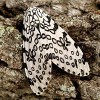Abstract
The giant leopard moth is our largest eastern tiger moth. It was formerly in the family Arctiidae, which now composes the subfamily Arctiinae in the family Erebidae. Giant leopard moths are nocturnal. Males are commonly attracted to lights at night. Sometimes dozens of males come to bright lights set out in good habitat. This 6-page fact sheet was written by Donald W. Hall and published by the UF Department of Entomology and Nematology, August 2014.
References
Arnaud PH. 1978. A Host-Parasite Catalog of North American Tachinidae (Diptera). United States Department of Agriculture Miscellaneous Publication 1319. Washington, D.C.
Beadle D, Leckie S. 2012. Petersen Field Guide to Moths of Northeastern North America. Houghton Mifflin Publishing Company. New York, New York. 611 pp.
Butterflies and Moths of North America. http://www.butterfliesandmoths.org/species/Hypercompe-scribonia
Concello, JA, Jr. 1970. A new food plant record for Ecpantheria scribonia (Arctiidae). Journal of the Lepidopterists' Society 24: 227.
Corcoran AJ, Conner WE, Barber JR. 2010. Anti-bat tiger moth sounds: form and function. Current Zoology 56(3): 358-369. https://doi.org/10.1093/czoolo/56.3.358
Corcoran AJ, Barber FR, Hristov NI, Conner WE. 2011. How do tiger moths jam sonar? The Journal of Experimental Biology 214: 2416-2425. https://doi.org/10.1242/jeb.054783
Covell CV. 2005. A Field Guide to the Moths of Eastern North America. Virginia Museum of Natural History. Special Publication Number 12. 496 pp.
Dyar H. 1891. Notes on the life history of Ecpantheria scribonia, stoll. The Canadian Entomologist 23:106-108. https://doi.org/10.4039/Ent23106-5
Fullard JH, Napoleone N. 2001. Diel flight periodicity and the evolution of auditory defenses in the Macrolepidoptera. Animal Behaviour 62: 349-368. https://doi.org/10.1006/anbe.2001.1753
Habeck DH. 1987. Arctiidae (Noctuoidea). In Stehr FW. (ed.). Immature Insects. Kendall/Hunt Publishing Company. Dubuque, Iowa. pp. 538-542.
Heppner JB. 2003. Lepidoptera of Florida. Part 1. Introduction and Catalog. Volume 17 of Arthropods of Florida and Neighboring Land Areas. Division of Plant Industry. Florida Department of Agriculture and Consumer Services. Gainesville, Florida. 670 pp.
Honey MR, Young M. 1997. The correct name of the North American great leopard moth. Entomologist's Record and Journal of Variation 109: 25-27.
Krombein KV, Hurd Jr.PD, Smith DR, Burks BD. 1979. Catalog of Hymenoptera in America North of Mexico. Volume 1. Symphyta and Apocrita (Parasitica). Smithsonian Institution Press. Washington, D.C. 1198 pp.
Layne JR. 2005. Freeze tolerance and cryoprotection in caterpillars of the giant leopard moth (Ecpantheria scribonia) (Lepidoptera: Arctiidae). Journal of Thermal Biology 30: 267-271. https://doi.org/10.1016/j.jtherbio.2004.12.006
Minno, MC, Minno AK. 1991. A Florida leopard moth with missing spots (Lepidoptera: Arctiidae). Tropical Lepidoptera 2: 52.
North American Moth Photographers Group map. http://mothphotographersgroup.msstate.edu/large_map.php?hodges=8146
O'Hara JE. 2013. Taxonomic and Host Catalogue of the Tachinidae of America North of Mexico. (Last update: 10 December 2013)
Plants Database. 2014. USDA Natural Resources Conservation Service.
Robinson GS, Ackery PR, Kitching IJ, Beccaloni GW, Hernândez LM. HOSTS - a Database of the World's Lepidopteran Hostplants.
Simmons R. 2009. Adaptive coloration and mimicry. In Connor, WE, (ed.). Tiger Moths and Woolly Bears: Behavior, Ecology, and Evolution of the Arctiidae. Oxford University Press. Oxford, U.K. pp. 115-126.
Singer S, Bernays EA. 2009. Specialized generalists: behavioral and evolutionary ecology of polyphagous woolly bear caterpillars. In Connor, WE, (ed.) Tiger Moths and Woolly Bears: Behavior, Ecology, and Evolution of the Arctiidae. Oxford University Press. Oxford, U.K. pp. 103-114.
Wagner DL. 2005. Caterpillars of Eastern North America. Princeton University Press. Princeton, New Jersey. 512 pp.
Wagner, DL. 2009. The immature stages: structure, function, behavior, and ecology. In Connor, WE, (ed.) Tiger Moths and Woolly Bears: Behavior, Ecology, and Evolution of the Arctiidae. Oxford University Press. Oxford, U.K. pp. 31-53.

